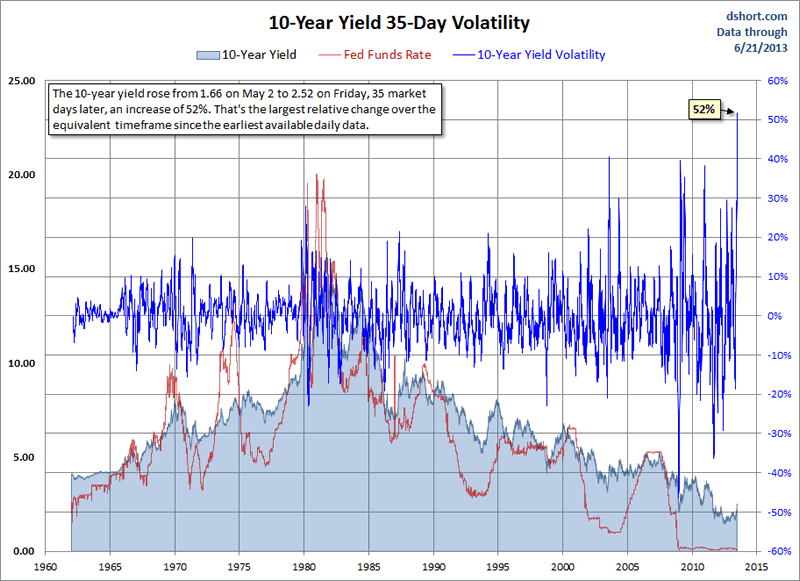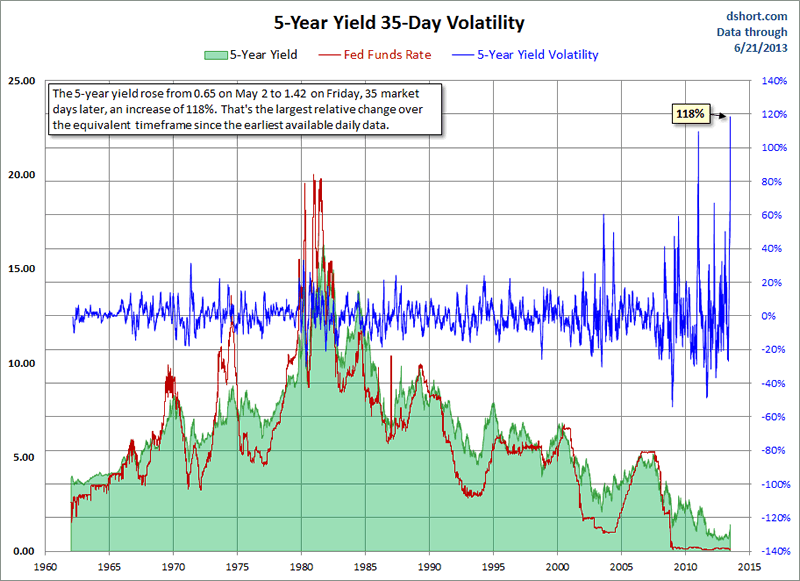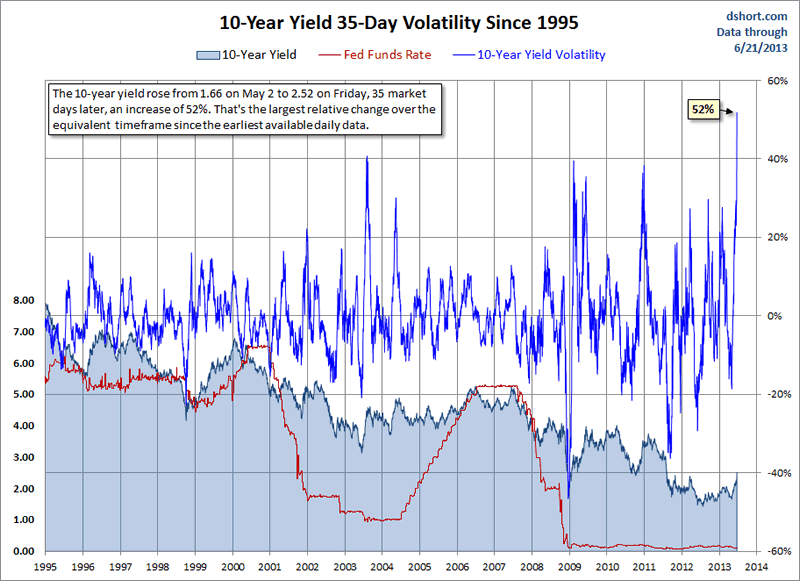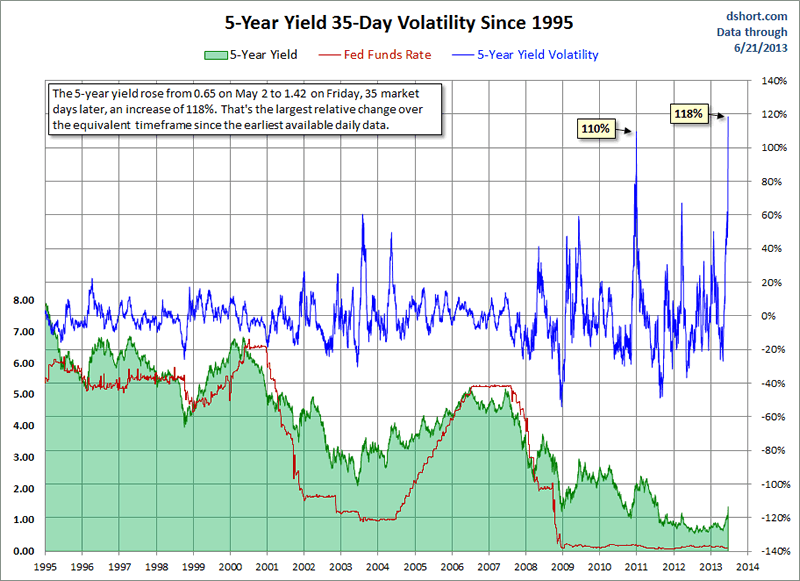How Recent Surge in Yields Compares with the Past
Interest-Rates / US Interest Rates Jun 24, 2013 - 05:24 PM GMTBy: PhilStockWorld
 Courtesy of Doug Short : The bond market selloff after the FOMC meeting and Chairman Bernanke’s surprising specifics about exiting QE was quite stunning. However, his hawkish position was supported by today’s release by the Bank for International Settlements (BIS) of its annual report. The abstract for opening section, headed Making the most of borrowed time, begins with the following assertion:
Courtesy of Doug Short : The bond market selloff after the FOMC meeting and Chairman Bernanke’s surprising specifics about exiting QE was quite stunning. However, his hawkish position was supported by today’s release by the Bank for International Settlements (BIS) of its annual report. The abstract for opening section, headed Making the most of borrowed time, begins with the following assertion:
Originally forged to describe central banks’ actions to prevent financial collapse, “whatever it takes” has become a rallying cry for them to continue their extraordinary policies. But we are past the height of the crisis, and the goal of policy today is to return to strong and sustainable growth.
The closing section of the report, Monetary policy at the crossroads, is especially supportive of Chairman Bernanke’s remarks on ending QE.
With monetary policies remaining very accommodative globally, central banks continue to borrow time for others to act. But the cost-benefit balance is inexorably becoming less and less favourable. Furthermore, the postponement of the inevitable exit from these policies poses increasing challenges for central banks. They must re-emphasise their stability-oriented framework for monetary policy, although in a way that takes greater account of both financial stability concerns and global policy spillovers.
Prior to the FOMC drama, Treasury yields had been rising since their interim low in early May. But Wednesday during Bernanke’s press conference, yields began soaring and the selloff accelerated. The 10-year note yield closed at 1.66 on May 2nd. It closed Friday at 2.52, up 86 bps. Expressed as a percentage gain, that’s a rise of 52% in 35 market days. The 5-year yield went from 0.65 to 1.42, up 77 bps, a 118% increase.
To put the selloff in its historical perspectives, I’ve plotted the 35-day volatility for these two Treasury yields since the earliest Fed record of daily closes in 1962. Expressed as a percentage increase, the rise in yields since May 2nd is unprecedented. Here is the 10-year note yield with its 35-day volatility. I’ve also included the Fed Funds Rate to help us understand how the latest volatility compares with periods when the FFR changes.

Here is the same chart with the 5-year note.

The long timeframe of the two charts above includes the era of stagflation and a FFR north of 20%. Here are the same charts with a 1995 starting point, the year before Chairman Greenspan made his famous reference to irrational exuberance.


Of course, the 52% surge in the 10-year yield from 1.66 in early May is far less shocking than a 52% jump would have been in early 1995 when the yield was hovering around 7.80. Nevertheless, the action in Treasuries will be important to watch in the coming weeks.
Was the Fed’s Hawkish Stance Warranted?
Opinions about the latest FOMC meeting and Bernanke’s press conference are quite divided. The day after the press conference Nobel laureate Paul Krugman, never one to mince words, savagely attacked Bernanke’s taper talk:
| My reaction is, this [hawkish stance] is not good. They might get away with it, but there?s also a serious chance that this will end up looking like a historic mistake….
I know that the latest had overwhelming support on the FOMC; I?m surprised and a bit shocked by that, and worry that we may have seen incestuous amplification at work. I really hope that the real economy recovers at a pace that makes my fears groundless. But if it doesn?t, I fear that the Fed has just done more damage than it seems to realize. |
It’s not surprising that Krugman disagrees with the FOMC and Bernanke in particular, but “incestuous amplification“ is a bit over the top … even for Krugman.
On the other hand, the position of the Bank for International Settlements articulated in its annual report is a strong endorsement of the Fed’s apparent shift in policy.
- Phil
Philip R. Davis is a founder of Phil's Stock World (www.philstockworld.com), a stock and options trading site that teaches the art of options trading to newcomers and devises advanced strategies for expert traders. Mr. Davis is a serial entrepreneur, having founded software company Accu-Title, a real estate title insurance software solution, and is also the President of the Delphi Consulting Corp., an M&A consulting firm that helps large and small companies obtain funding and close deals. He was also the founder of Accu-Search, a property data corporation that was sold to DataTrace in 2004 and Personality Plus, a precursor to eHarmony.com. Phil was a former editor of a UMass/Amherst humor magazine and it shows in his writing -- which is filled with colorful commentary along with very specific ideas on stock option purchases (Phil rarely holds actual stocks). Visit: Phil's Stock World (www.philstockworld.com)
© 2013 Copyright PhilStockWorld - All Rights Reserved Disclaimer: The above is a matter of opinion provided for general information purposes only and is not intended as investment advice. Information and analysis above are derived from sources and utilising methods believed to be reliable, but we cannot accept responsibility for any losses you may incur as a result of this analysis. Individuals should consult with their personal financial advisors.
PhilStockWorld Archive |
© 2005-2022 http://www.MarketOracle.co.uk - The Market Oracle is a FREE Daily Financial Markets Analysis & Forecasting online publication.



